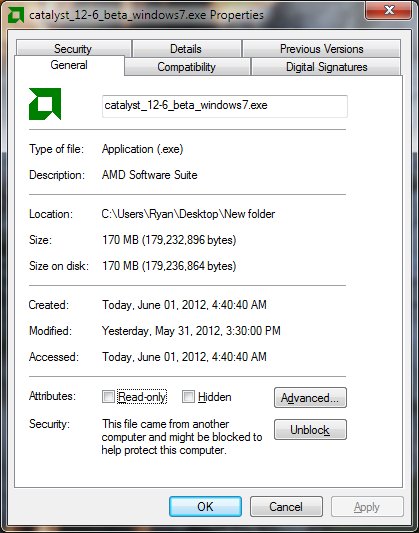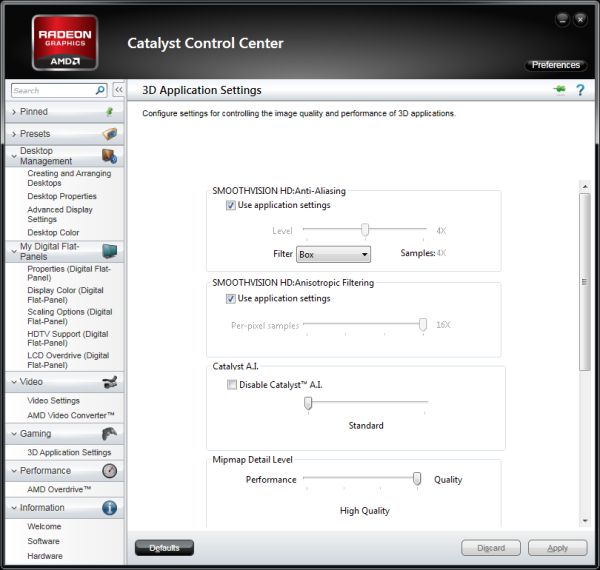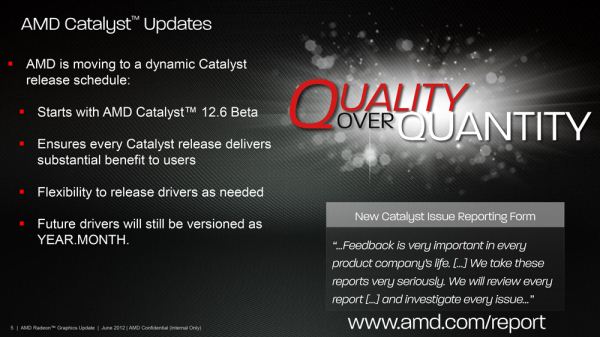AMD Discontinues Monthly Driver Updates, Releases Catalyst 12.6 Beta
by Ryan Smith on June 1, 2012 9:00 AM ESTThe last month or so has been one of transition for AMD’s Catalyst driver crew. Alongside the launch of AMD’s Trinity APU – complete with what’s only AMD’s 2nd VLIW4 GPU – AMD has also been hard at work on preparing their next Windows 8 drivers, and on the development side of things AMD also put plans into motion to move their DX10 GPU families to legacy status. Capping this off, AMD’s driver team is embarking on one more change, and for long-time AMD followers it’s going to be a doozy.
For the better part of a decade now AMD (née ATI) has released new WQHL-certified video drivers on a monthly basis. In principle this enables AMD to offer driver updates on a predictable schedule, and to spread out major driver changes over a few versions of the driver. In practice this is exactly how things have worked up until the last couple of years, which is why we’ve been fans of AMD’s driver update schedule for the longest time.

ATI Catalyst 3.8
With that said, that time has come to a close. AMD has announced that starting with Catalyst 12.6 AMD will be ceasing their monthly driver update schedule in favor of releasing drivers on a dynamic/as-needed basis, effectively taking up NVIDIA’s driver release schedule. Instead of 12 monthly WHQL releases plus a smattering of beta and hotfix drivers, AMD will have what we’d estimate to be around half as many WHQL releases alongside an unknown number of beta driver releases. It’s a significant change for AMD’s Catalyst crew and one we’re glad to see they’re making.
Why? As we briefly mentioned before, the benefits of AMD’s monthly driver release schedule were realized in practice for quite some time, but only up until the last couple of years. Starting around the release of the HD 5000 series though those benefits became harder to realize and less meaningful. The issue is at its basic level one of complexity – AMD’s drivers continue to grow in size and complexity, with the latest release weighing in at 170MB. Video drivers have effectively eclipsed Windows 95 in complexity and size in the last couple of years, which reflects the fact that these devices really have become processors, complete with all the intricacies of code compilation and scheduling, and basically in need of a mini-OS just to run them.

The result has been that AMD (and NVIDIA too) have both seen their driver development schedules become more drawn out. For AMD this has meant fewer major driver branches are released in any given year as it takes them longer to research, develop, and assemble the various optimizations and features that are added to their drivers. Consequently the need to release drivers on a monthly basis has led to some driver releases that bring few if any changes, as AMD has no new additions to that driver branch as they work on the next branch. In other words, AMD’s monthly commitment meant AMD had to release drivers whether they had something new or not.
Really this branch problem came to a head in the later part of last year with AMD’s disastrous October driver releases where they ended up with several different drivers being released in the same month; a regular Catalyst release, a BF3 release, and a Rage release that didn’t contain the BF3 improvements. Even without a fixed driver release schedule AMD will still have driver branches and the need to manage the development of multiple branches at once – that’s just the reality of this kind of software development – but it will free up resources that previously needed to be committed to the monthly driver, and in all likelihood it will make project management easier for AMD by making it push major development along a single branch (avoiding a BF3/Rage situation).
As it stands AMD has already missed one monthly driver drop with Catalyst 12.2 (the first regular driver in the 7000 series branch), and AMD will have missed another monthly driver drop with 12.5, which missed its May deadline. It’s clear that thanks in large part to these jumps in complexity and development time that monthly driver releases have become unsustainable for AMD, and behind the scenes we’ve been prodding AMD to move to a dynamic schedule for that exact reason. This makes us all the more glad to see that rather than foolishly try to keep up with this schedule that they’re backing off from trying to release so many drivers.

Modern Catalyst Control Center
However it would be remiss of us to not point out a second, more practical reason for this change too: a reduced necessity. Prior to 2010, full Catalyst driver releases were the only way for AMD to release any kind of driver change. That changed with Catalyst 10.2, which saw the introduction of Catalyst Application Profiles (CAPs). CAPs were primarily created to ease the distribution of new game profiles for Crossfire, but in some cases more general single-GPU problems can be fixed in those profiles. By manipulating the various compatibility settings in their profiles AMD can fix some issues without requiring a driver update, such as CAP 12.4-2 which improved the performance of Max Payne 3 for both single video cards and Crossfire configurations. Larger issues still require a full driver release of course, but compared to years before the advent of CAPs there’s definitely a reduced need thanks to the separation of driver and profile.
Going Forward
As we stated earlier, AMD will be moving to a dynamic/as-needed schedule for driver releases. It’s their hope – as it is ours – that they’ll be able to further improve on the quality and meaningfulness of Catalyst driver releases. Certainly this will cut out the release of near-useless Catalyst drivers, whereas quality as always remains to be judged. Realistically AMD’s most immediate goal should be to do a better job of getting drivers out for major new games as necessary, as that’s something they’ve particularly struggled with and is the thing the new schedule should help the most with by freeing up resources.
To that end the Catalyst 12.6 driver, released in beta form today, will be the first such driver release. We haven’t had a chance to evaluate these drivers in depth yet, but they are from AMD’s latest driver branch and should contain the typical assortment of performance improvements and bug fixes that we’ve come to expect from a major Catalyst release.
Also, it should be noted that while AMD is changing their release schedule their naming schedule is not changing. Catalyst drivers will still be named by [Year].[Month], which unfortunately means there are going to be holes in AMD’s numbering scheme. A month without a driver will simply be empty, so they could go from 12.6 to 12.8, for example. Importantly for non-technical users however this means that they maintain the date in the driver number, making it easy to tell whether a driver is recent or not.
On that note, the one thing AMD hasn’t changed so far but bears mentioning as something we’d like to see changed is AMD’s website. It has always been difficult to find AMD’s beta drivers from inside their website, a problem that is only going to become worse with the change in the release schedule. AMD needs to use this opportunity to change their site so that beta drivers are as easy to find as WHQL drivers, something that quite frankly NVIDIA has done a solid job of.
Finally, alongside the change to their driver release schedule AMD is also instituting a new driver report form to replace the older Catalyst Crew Feedback Form, which is being called the AMD Issue Report Form. The goal is the same, but AMD is moving to this new form in an attempt to gather better feedback from users than what the old form collected. If nothing else, we hope that AMD does a better job of keeping the form visible, as there seems to have been a lot of AMD users that simply never knew about the Catalyst Crew form.
Addendum: We've been informed by AMD that with the release of the Catalyst 12.6 betas, Catalyst 12.5 has been canceled entirely. 12.6 is what 12.5 would have been, and this has special significance for AMD's DX10 generation GPUs. 12.5 was supposed to be the last monthly Catalyst release that supported those GPUs but Catalyst 12.6 beta doesn't support them. So it's not clear when DX10 GPU owners will see a new driver; if this is the start of AMD's "quarterly" update cycle, then it may be a few months, making 12.4 the final driver for the time being.











77 Comments
View All Comments
Malih - Friday, June 1, 2012 - link
regardless of manufacturers, based on my experience multi GPU setup has the most issues,so you might want to consider that because your previous 7950GTX setup was a single GPU setup before deciding on AMD/nVidia,
check carefully which driver is better in the case of multi GPU.
Spunjji - Friday, June 1, 2012 - link
*yawn*Golgatha - Monday, June 4, 2012 - link
Me too. I can almost guarantee they'll take 2-3 months for each release and they still won't be able to write a stable set of drivers to save their collective asses.hansmuff - Thursday, June 7, 2012 - link
I gave up on NVIDIA drivers after they messed up fan control and killed large swaths of cards, my 8800GTS512 included.THAT was an example of real failure. If a game has problems for a month, I can live with that. But the fanbois like sweeping this particular one under the rug, and it killed cards.
nathanddrews - Friday, June 1, 2012 - link
Just bought a laptop with a 2670QM and a Radeon 7670M. Terrible driver support. AMD won't recognize it and the only driver is from Acer and weighs in at 380MB. You also have to manually copy over several files in order to get 64-bit OpenGL support, otherwise all 64-bit OGL applications crash upon execution. Also, the switchable graphics is spotty at best.NVIDIA from now on. Being able to use one driver package for all GPUs - and have it work - is worth paying more.
ShieTar - Friday, June 1, 2012 - link
Not really specifically an AMD topic. I had a laptop with a nVidia Go 440 a few years ago, which also was completely unsupported by nVidia drivers. Not much either nVidia or AMD can do if somebody decides to buy their chips and build them into a custom graphics card that is not supported by their drivers.prophet001 - Friday, June 1, 2012 - link
thisDribble - Friday, June 1, 2012 - link
I think it is specifically an AMD problem.As I understand it for mobile with AMD you have to get driver updates from the maker of your laptop (e.g. acer). This means that it can take for ever to get fixes.
With nvidia you just download the standard driver package from nvidia released at the same time as the desktop ones.
This is the reason I stick to nvidia in any laptop I buy.
LoneWolf15 - Saturday, June 2, 2012 - link
It is not specifically an AMD problem, unfortunately. There are plenty of laptops that require vendor specific drivers on both sides.Also remember that we have nVidia to thank for an entire generation of failing mobile GPUs resulting in a class-action lawsuit being required for any resolution to happen.
There have been plenty of missteps from both suppliers. No-one is immune. For the average user to say "ATI drivers suck" as a blanket statement ignores a lot of great products with no issues. It also ignores the issues nVidia has had, sometimes with drivers, sometimes with hardware, in their own products.
Not being an early adopter of either vendor's products is a wise move, but it's possible to get burned either way.
Penti - Sunday, June 3, 2012 - link
That is true for any gpu, Intel, AMD or nVidia. Blame the vendor. Updated drivers are vital, you won't even be able to upgrade/update Windows otherwise.